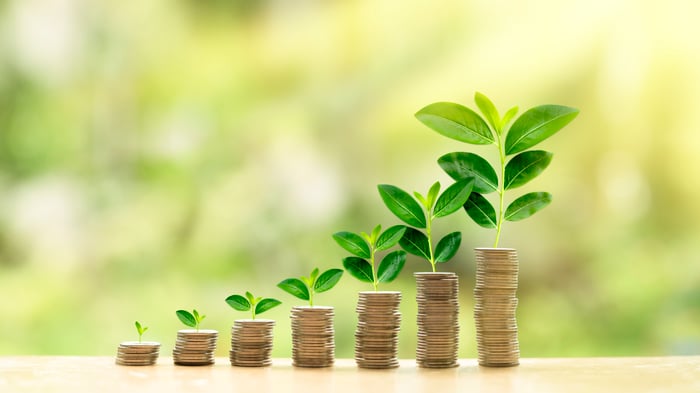As a retiree, you have to figure out how to help your money both cover your costs today and potentially last at least as long as your retirement does. That can be a tough balancing act to achieve. After all, every dollar you spend from your account is a dollar that can no longer compound on your behalf to potentially cover your future expenses.
One strategy that some retirees follow is to seek out investments that pay decent dividends. Their hope is that dividends will give them cash to help replenish the money they're spending to cover their daily expenses without forcing them to sell their ownership stakes. If those dividends not only get paid but also increase over time, they could potentially even help that retiree keep up with inflation.
While that seems awesome on the surface, the biggest problem with that strategy is that dividends are never guaranteed payments. If the economy or their operations turn sour, companies can cut their dividends to attempt to protect the rest of their business.
As a result, rather than owning individual dividend-paying companies, some retirees look toward dividend-focused exchange-traded funds (ETFs) for a way to help replenish their spending cash over time. With that in mind, these three dividend ETFs may very well end up as a retiree's best friend.

Image source: Getty Images.
No. 1: Vanguard's Real Estate ETF
The Vanguard Real Estate Index Fund (VNQ -0.80%) seeks to own property-focused real estate investment trusts (REITs). People have traditionally owned investment real estate for its ability to generate cash from rental payments. REITs offer the opportunity to tap in to that potential cash flow without the headaches associated with directly being a landlord.
In particular, REITs must pay out at least 90% of their income in the form of dividends. As a result, investors can be fairly confident that as long as the companies in that fund are profitable, they will receive dividends from the fund. The Vanguard Real Estate Index Fund sports a yield of around 4.7%, which makes it tempting for investors who are seeking current income.
No. 2: Vanguard's Dividend Appreciation ETF
The Vanguard Dividend Appreciation ETF (VIG -0.15%) attempts to track the S&P Dividend Growers index. That index seeks out companies with at least a 10-year track record of annually increasing their dividends, while filtering out the highest yielding 25% of companies that would otherwise qualify.
On the surface, it might seem strange for an income-focused index to filter out high-yielding companies. A key reason it does that, though, is that super high reported yields often signal a yield trap -- a sign that the company's dividend is unsustainable and at risk of being cut. While not a perfect filter, it does help the index and ETF focus on dividend increases rather than raw yield.
As is fitting for an ETF more focused on dividend growth than on high yield, the Vanguard Dividend Appreciation ETF currently sports a yield of around 2%.
No. 3: A leading energy-infrastructure ETF
If seeking high current yield is important, then consider the Global X MLP & Energy Infrastructure EFT (MLPX 0.47%). That ETF tips the scales at around a 5.4% current yield , and it does so by being focused largely on owning pipelines and other energy infrastructure companies .
Pipelines tend to be one of the most cost-effective ways of moving natural gas and oil around from where it's produced to where it's processed or used. That reality means that as long as we rely on those types of fossil fuels, it is likely that pipelines will play a key role in that type of transport. While pipelines have a large up-front cost associated with them, their relatively low operating costs and high potential for long-term demand are what enable them to pay such big dividends.
Note that political opposition to new pipeline construction is something of a double-edged sword for the industry. On one side, that opposition makes new construction more expensive, which in turn makes existing pipelines that much more valuable. On the other side, that same opposition serves to curtail the potential growth in the industry, which means investors shouldn't expect big dividend increases unless that opposition somehow reverses.
Get started now
One key thing to know about dividends is that, in order to receive one, you need to own shares of the payer before its ex-dividend date and then hold those shares until at least that ex-dividend date. As a result, if you're looking for income from any of these three ETFs, the sooner you invest, the sooner you're likely to start that income stream. So make today the day you decide whether one or more of them may be worth a slot in your portfolio.





